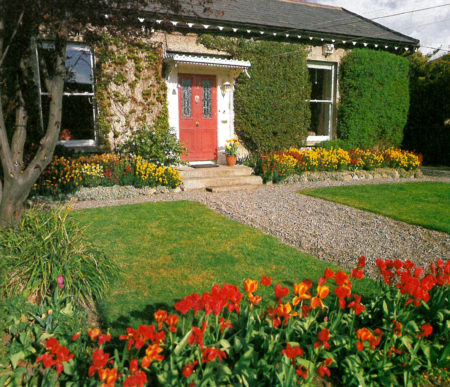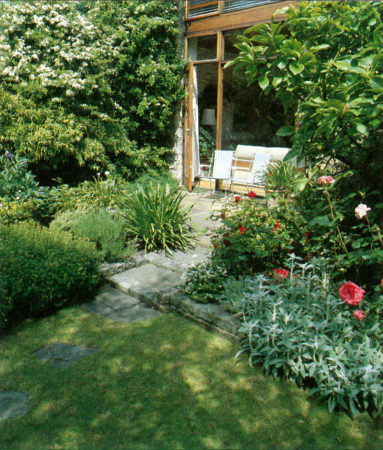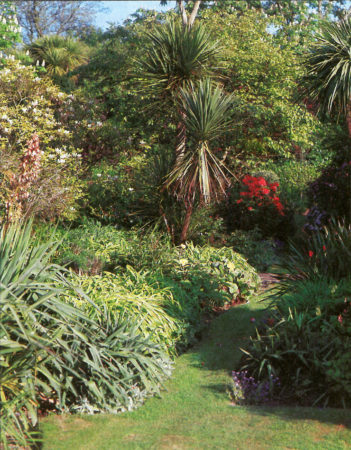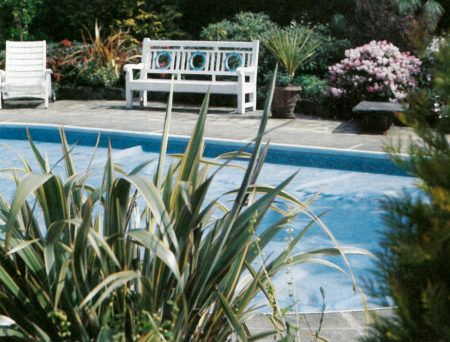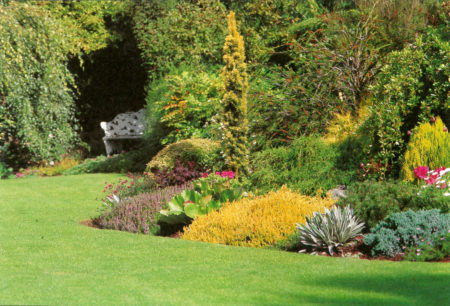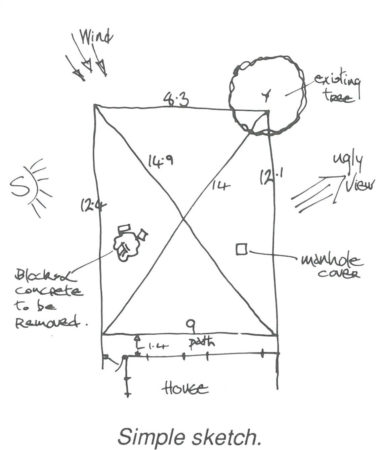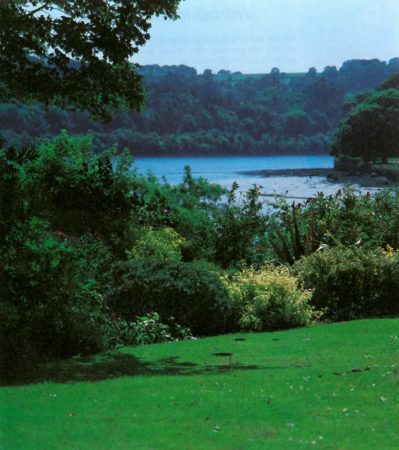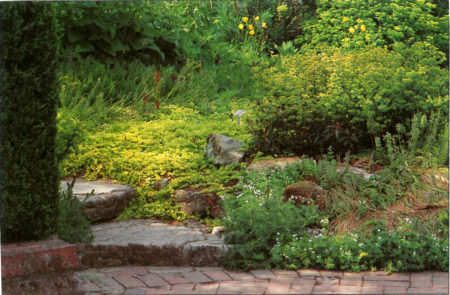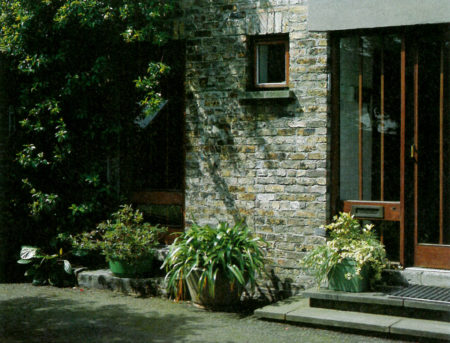Post category: Assessment
House Style
The garden should always match the style of the house. Old houses should have something of the garden style appropriate to their age. Of course, it may not be possible to restore this exactly, because labour was very cheap then, but some few features of the fashion of former days will look right.
A Victorian house might, for example, have some dark broad-leaved evergreens, hedges, a gravelled path or two, and some small box-edged flower beds.
A modern house would look ridiculous with those garden features. It should have a free-flowing style – a few well-chosen, carefully placed trees; good-sized groups of mixed planting, lots of ground-cover and some dramatic individual plants. This is a ‘clean’, modern style in keeping with modern architecture.
A large house will need big plants to balance it. However, on a restricted site, a lot can be done with creepers and tall, narrow trees to make a large house sit more comfortably.
Garden style
Although the style should match the house, this is really a matter of personal taste. Usually, the taste that informs the choice of home fittings and decoration will exert the same influence on the garden.There are as many styles as there are people but the choice might resemble one of the following types: a simple, strong style (paving and a few plants), a quiet, retiring style (lawn, hedges and rose beds), a brash, show-off style (lots of bright bedding and window boxes), or a fussy, homely style (lots of pale coloured flowers and bulbs, mixed with shrubs).
Needs
Plants can be dangerous – poisonous, sharply spined, or just badly placed where the unwary might trip.
The garden can be made enjoyable for every user. Smooth, firm surfaces and gentle slopes for those who find it hard to get about; safe play areas for children; comfortable shade for the elderly (and the fair-skinned!); raised beds for those with difficulty in bending; scented plants for the blind.
Function
The garden has an important ornamental function, providing pleasant surroundings for the home, an attractive scene for the passerby. Leisure uses are an important function – sitting out, sunbathing, strolling, entertaining, children’s play, even sport like tennis, or swimming (if you have a pool!)
The garden can be used for keeping pets – cats, dogs, fish, even bee-keeping in rural areas. The production of fresh fruit, vegetables and herbs can be considered an important function for the garden; cut flowers for indoor decoration may be required.
The garden may be required to hold a hobbyist gardener’s collection – alpines, roses, bonsai and many others. There is also the opportunity for self-expression, arranging plants to achieve desired effects of colour and form.
Practical functions like the clothes-line, fuel tank, tool shed, compost heap, and possible septic tank must be taken into account and placed where they are convenient without spoiling the garden.
Everybody has their own favourite plants – trees, dwarf conifers, heathers, rockery plants, bog garden plants, or favourite flowers such as sweet peas, roses, lilies, irises, and thousands of others.
Make provision for your favourites in terms of space and suitable conditions
Click here to view bigger sized image
Make provision for your favourites in terms of space and suitable conditions. Favourite plants can influence other aspects of the garden design. For example, an interest in climbing roses, or clematis, will necessitate fences, trellis or walls on which to grow them.
Some choices will rule out others; it is not possible to fill the garden with trees and still have a decent lawn, or rockery with alpine plants, because of the shade they cast, but it would be possible to have a fernery, for instance.
As with plants, everybody has favourite garden features. Most people like to have a paved area, others like a water feature, or containers, statues, drystone walls, scree beds, garden lighting, balustrades and steps, pergolas, timber seats, imposing gate pillars, fountains, secret gardens, trellis fences, even garden gnomes!
A five-acre garden will accommodate all of these and a multiplicity of plant preferences as well. Small gardens are more limited, and it is best to stick to a few firm favourites, and not to try to fit in too much.
Professional advice can be sought and will cost a certain amount of money, but it will be money well spent. Any garden designer will testify that they are frequently called in when mistakes have been made, and money has been unwisely spent.
Some garden features cost more than others. Lawns are the cheapest garden feature; they even sow themselves as ‘tumbledown’ if left to their own devices! Conservatories, paving, walls, terraces and water features are among the more expensive features.
In general, plants are cheap compared to non-living features like paving, walls and fences. Bedding plants are often considered cheap compared to more permanent trees, shrubs and perennial flowers. However, the expense of three or four boxes of bedding plants each year is equivalent to one decent tree, three or four shrubs and perhaps eight or ten perennial flowers. Perennial plants not only grow in size each year, but new plants can be raised from cuttings, or by division.
Money can make up for lack of time available by paying to have the garden made and maintained by a contractor. Equally, if you have plenty of time available, you can save money by do-it-yourself construction and the propagation of plants from seeds and cuttings.
Space
Where there is room for large plants, small plants never achieve the desired result, even when used in numbers.
Where there is room for large plants, small plants never achieve the desired result, even when used in numbers
Click here to view bigger sized image
Equally, care must be taken not to use over-large plants in a small garden. There are plants suitable for every size of garden. Usually, there isn’t much can be done about the amount of space available; the challenge is to use it to best effect.
Time
Some garden features are very time-consuming – large lawns, hedges, rose beds, bedding plants, containers, rockeries, fruit and vegetables. On the other hand, trees, shrubs, most perennial flowers, ground-cover, walls and fences, paved areas, scree gardens, small lawns, wildflower meadows, and pools have lesser time demands. See Labour Saving.
Each square metre of lawn will need about three minutes each year for mowing alone; there will be feeding and lawn edging as well. If you have a quarter-acre to mow, the annual total will come to seven eight-hour days!
Each square metre of trees and shrubs can be maintained in about twenty seconds per year, or six hours for the same quarter-acre. Remember also that the trees will need less time as they mature; the gardener maturing at a similar rate.
Plan
Make a sketch of the site on a piece of paper marking in all the existing objects and features. Measure the size of the garden, either by pacing it roughly, or using a tape. Take diagonal measurements from corner to corner to give the correct angles made by the boundaries.
Make a sketch of the site on a piece of paper marking in all the existing objects and features.
Click here to view bigger sized image
Very few plots have right angle corners! Measure existing buildings, paths, driveways and walls. Measure the position of trees from walls or the house itself. Note the spread of their branches. Record other plants, flower beds and lawns, if these are to be retained. All drains, wires and septic tanks should be accurately recorded. Take note of the position of the sun at midday.
Using the rough sketch of measurements and other notes, draw a reasonably accurate plan of the garden site. A drawing of the garden to scale is an invaluable part of the process. The simple sketch can do well enough but not being to scale, it can be misleading.
The drawing allows various ideas to be tried out on photocopies; it gives a better chance of getting things into correct proportion, and it acts as a record of planting for the future.
Use a large sheet of paper to draw a garden plan. It is much easier to draw on a large scale than a small one where there will not be enough room to display individual plants properly.
Viewed from above, nearly all plants look circular in outline; therefore, a circle on the sheet of paper will represent a tree or shrub very well. Mark a heavy dot in the middle for the trunk. If there are several plants of the same kind in a group and they are growing into each other, the group can be represented by the appropriate number of overlapping circles. Each plant’s position can be marked with a dot, a cross, or a small ring.
Buildings, walls, fences and pathways when viewed from above look like squares, rectangles, straight lines, parallel lines and curving lines, as appropriate. These shapes can be used to represent such objects in the garden plan.
Drawing to scale
A plan drawn to scale is very much like an aerial photograph of the site taken directly above it. Imagine a bird’s eye view looking straight down.

A plan drawn to scale is very much like an aerial photograph of the site taken directly above it
Click here to view bigger sized image
Allowing one centimetre to each metre (or step) measured, gives a one-in-one hundred scale; two centimetres to each metre gives a one-in-fifty scale. One centimetre in a 1:50 drawing would be equivalent of fifty centimetres of actual garden.
It is then easy enough to assess how much space there is available in any given spot, and to instantly know whether a two-metre wide shrub will actually fit; it would need four centimetres on your drawing. If there is only two centimetres available, it will be too big in five years time!
Size
The size of the garden is a very important factor in deciding which features and plants to use. From the plan measurements, work out the area of garden. This may also be available from the documents of sale for the property, or architect’s drawings.
Soil
The type of soil should be noted. Dig a hole about 50 centimetres deep and 50 centimetres wide. You will be able to see what depth of dark top-soil there is. The subsoil is much paler than the top-soil, it is quite poor. If it is nearly as brown, then it is good soil – suitable for everything. If the subsoil is bluish and sticky, the ground is waterlogged and only plants that like wet ground can be grown.
Examine the soil for structure. Is it crumbly and open, or heavy and sticky? Has it a lot of stones, or is it sandy or clayey? Feel the soil between your fingers to decide on this. Sandy open soils are easy to work but tend to dry out in summer. Sticky clay soils are often fertile but lumpy and heavy to work. The ideal is in-between.
A soil test should be done to see if it is acid or limey. Test kits can be got in any garden shop. Pink or red flowers on hydrangeas indicate a limey soil; blue flowers, an acid one. Purplish hydrangeas indicate a neutral soil – neither acid nor limey. Rhododendrons in local gardens growing in the open ground will confirm acid soil. Soil does not change very much within the immediate neighbourhood, but a test will make sure.
Drainage
The ability of the soil to allow water to drain away is very important. Winter is the best time to assess drainage. Dig a few holes and see if they fill with water and how long it takes to drain. A useful rule of thumb is to note whether water lies on the surface for more than one full day after heavy rain stops. It if does, steps should be taken to improve drainage by means of a soak-hole for small areas, or plastic drainage pipes to a proper outfall on larger sites.
Slope
Record any significant slope, where it begins and how much of a fall there is. This will affect drainage but will also have a major influence on how the ground is finally laid out. The amount of slope can be accurately measured by moving along a line of pegs set at regular intervals with a straight length of timber and a spirit level.
Record the drop at each peg. The total figure for all the pegs gives an accurate measure of the fall. This will be especially important where it is necessary to estimate the height of terraces or retaining walls.
Site clearance
Site clearance may be necessary. Gather stones or builder’s debris by hand, or it can involve the removal of old buildings, stumps or other obstacles with power machinery. Before moving any obstacles, first consider how it might be used as part of the garden design, avoiding the need for removal.
Assess the need for earth-moving, such as levelling bumpy ground or making a slope less steep, or making terraces on sloping ground. The killing of existing stumps, scrub and perennial weeds, like nettles, docks, briars and bracken, can be necessary, and this should be noted.
Microclimate
Each location has its own special climate. If your garden is on the south-facing side of a hill, it will be sunny and warm. If you are at the top of a hill, wind exposure will be greater but, in its favour, an elevated site usually has nice views. Near the sea, salty winds can do a lot of damage, but a seaside garden suffers less frost.
Find out if the site is in a frosty locality. Areas within a few miles of the coast are less prone to frost; inland gardens are much colder. The presence of full-grown cordyline palms is a good indicator that the area is not frosty.

Work out the direction of the prevailing wind; mostly, it is from the southwest, but it can be influenced locally by the layout of the street, or nearby hills. Established trees will give a good indication of wind strength and direction; they lean away from strong winds. Noise from roads, or factories, can be a factor to consider. Dust can sometimes be a nuisance, too. Trees help to reduce both of these problems.
A successful design is one that is pleasing to the garden owner. There is room in gardening for every taste and no such thing as the ‘right’ way to do a garden. However, no matter what style is favoured, or taste is satisfied, there is such a thing as ‘good’ design – design that it is pleasing to a wide range of people, besides the owner.
Some people are instinctively good at design, any sort of design. Others have to think carefully about their efforts. It is useful to consider the elements of garden design – size, shape, colour and texture, space, light and shade, mystery and focus, unity and variety –
because they give some guidance on how to proceed.
Everything done with the garden counts as a design decision; even if we decide to do nothing at all, it is design by default!
Decisions about the features used, their position, and construction must be taken at every stage. Very often, such decisions are made instinctively, or by following a traditional formula, even if it is a bad tradition, such as planting a tree in the centre of a small lawn. It is worth giving active consideration to every decision, especially the really major ones. Every decision has consequences in terms of expense, time and maintenance.
It is not suggested that the positioning of every single plant must be agonised over; that is the other extreme. Instinct and taste must be trusted in making decisions, but they should be informed by some careful thought.
There are two questions to ask about any garden feature or plant. ‘Why am I using this feature, or plant?’ ‘Is this the best way to do the job?’ There should be good reasons why a feature or plant is being used; there should be good reasons for doing a job in a particular way.


